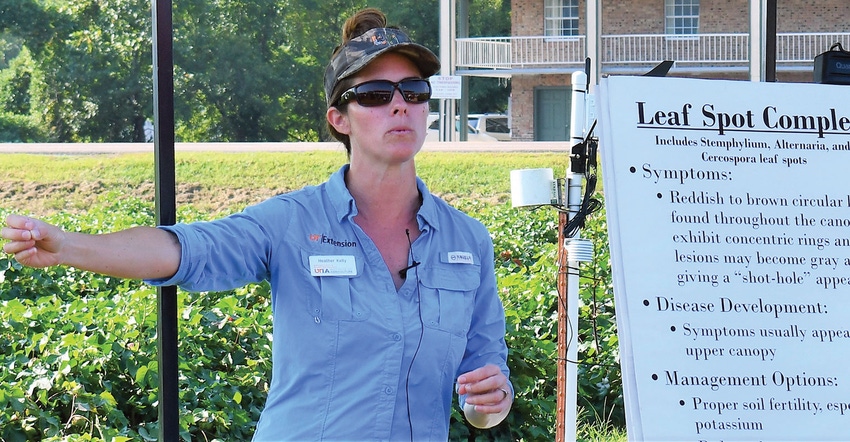
When it comes to cotton diseases, producers should watch for several factors and diagnosing a disease can be tricky. Dr. Heather Kelly, Extension researcher in plant pathology and IPM coordinator for the University of Tennessee, broke down a few common soilborne and foliar diseases in cotton at the 2019 Cotton Tour Field Day hosted by the West Tennessee Ag Research and Education Center, Jackson, Tenn.
Leaf spot complex
“This year I've gotten a lot of calls about leaf spot complex,” Kelly said at the first stop of the tour. “There is usually some spotting every year, but it can take on different appearances.”
Kelly also notes low potassium is associated with leaf spot complex, which appears as reddish to brown circular lesions found throughout the canopy. It may exhibit concentric rings and lesions, or it may become gray and dry, giving a “shot-hole” appearance.
“A treatment to address the low potassium should be all that is needed to address leaf spot complex. Oftentimes, a field might have enough potassium, but by the end of the year, you see spots develop, a sign the plant is trying to pull nutrients from the soil to finish out the season. This usually means you will have a good boll load on the plant, so the spots don’t necessarily mean you have a deficiency. It could just mean you are going to have good yield,” she said.
Once the spots show up, spraying a fungicide on them will not make a difference.
“These pathogens are opportunistic,” Kelly said. “You might be able to make the plant look less spotty, but you will have no response in yield.”
Stress from drought or waterlogged soil can also play a part in bringing out leaf spot complex. That is why proper soil fertility, especially potassium, and reducing plant stress, if possible, are the best management options.
Bacterial blight
“Another disease people are telling me has been a problem is bacterial blight,” she said. “Because this is a bacterium, it will not respond to a fungicide.”
The disease appears as lesions which start as tiny water-soaked spots that enlarge to dark brown, angular lesions limited by leaf veins. The lesions turn black as they expand if water-soaked on the underside of the leaf, and they can look like “shot-holes” as well. Bacterial blight may cause defoliation.
“One of those decisions a farmer needs to make going into the new year is, if they have had problems with bacterial blight, they need to choose a bacterial blight-resistant variety,” Kelly said.
For wet weather blight, which is circular, light brown lesions on cotyledons, leaves, stems, and bolls and can appear target-like, the best action is to avoid planting in cool, wet weather. Like bacterial blight, residue management is an option for treating this disease.
Target spot
Target spot is a newer concern, and it has brown lesions which can reach 1 inch in diameter, exhibits a series of concentric rings, and the lesions, as well as defoliation, will start in the lower canopy.
“We would recommend a fungicide application on this one,” she said. “It's a field-by-field basis when it comes to target spot. That is how it has always been and probably how it'll continue to be. Most of our data, though, show no yield response to a fungicide unless you have high disease pressure and have the right environment for it.”
Other management options include crop rotation and residue management. Kelly recommends not using a fungicide until target spot starts showing up in a field.
“For us, we’ve been noticing it about the third week of bloom,” she said. “The last component I want to emphasize is time. If you are late enough in the season, it may just help you with defoliation. If it’s early in the season, you still need to hold onto those leaves and protect with a fungicide.”
About the Author(s)
You May Also Like




